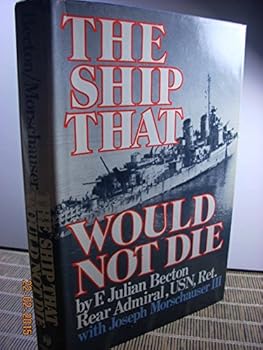Ship That Would Not Die
Select Format
Select Condition 
Book Overview
The ship and her men suffered the most intensive Japanese Kamikaze air attack ever hurled on one ship. The reader relives the ship's missions: rescuing downed airmen, her active fighting in the... This description may be from another edition of this product.
Format:Hardcover
Language:English
ISBN:0138089981
ISBN13:9780138089986
Release Date:January 1980
Publisher:Prentice Hall
Length:288 Pages
Weight:1.21 lbs.
Customer Reviews
1 rating
Moving Account of a Small Ship and its Crew
Published by Thriftbooks.com User , 23 years ago
I have just finished reading 'The Ship that would not Die' by Julian Becton. The book tells the story of the USS LAFFEY and the men who served on her during the Second World War. The book tells the story from the perspective of her commanding officer, Julian Becton, and covers the period from the USS LAFFEY's commissioning in 1943 till its de-commissioning in 1975. The main part of the story is of course the account of the USS LAFFEY's role fighting off twenty-two Japanese Kamikaze aircraft during the Okinawa campaign. However the book offers more than that, it starts with a short account of the first USS LAFFEY in World War Two which was lost during the fighting off Guadalcanal against the Japanese Battleship Hiei. An action that the author participated in while serving on the USS Aaron Ward.The author then takes us through the building of the new USS LAFFEY (DD724) , the assembly of its crew and officers, its commissioning and subsequent role in the Normandy campaign of 1944. The story then follows the USS LAFFEY to the Pacific where it took part in the campaign to liberate the Philippines. From there we follow the LAFFEY and crew to Iwo Jima and then to Okinawa where the USS LAFFEY was subsequently assigned a role in the Destroyer picket line.This picket line was a system designed to provide an early warning of approaching Japanese forces to the American fleet and assault troops fighting around Okinawa. The ships in this picket line also served as a lightning rod to the Japanese Kamikaze planes. For most part the destroyers and other ships were isolated from the main fleet and as such appeared to be easy targets for the Japanese. As the narrative unfolds in this book it shows that this was not always the case.On April 16th, 1945 whilst at radar picket station number 1 the USS LAFFEY was attacked by twenty-two Japanese aircraft. The destroyer took a hell of a beating but managed to stay afloat after massive damage and the loss of 32 men killed and 71 wounded, some with horrific injuries. I found that I managed to feel a deep respect not only for the crew, that's expected of course, but also for the Japanese flyers. I don't know if that was the author's intention but occasionally he would describe something that allowed you to visualize the young Japanese pilot in his cockpit as his plane is closing in for the final plunge into eternity. Then it hits you that these poor pilots were young men just doing their duty for their country just as much as the young American's trying to shoot them down.The narrative at times may come across a bit "corny" to some readers but the book was first published in 1980 and I believe the author is just conveying the feelings of those who served at that time. The story moves along at a quick pace and you really feel for some of the men, the silent heroes in this terrible incident, who died at their posts or in trying to save their ship mates. This is a good book and a great story of one ship and its brave crew durin






